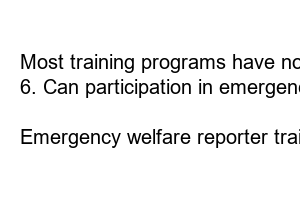긴급복지 신고의무자 교육
Title: Emergency Welfare Reporter Training: Enhancing Preparedness and Response Efforts
Subheadings:
1. Introduction: The Importance of Emergency Welfare Reporter Training
2. The Role of Emergency Welfare Reporters in Crisis Situations
3. Benefits of Emergency Welfare Reporter Training
4. Essential Skills and Knowledge Covered in the Training
5. How to Enroll in Emergency Welfare Reporter Training
6. Frequently Asked Questions (FAQs)
7. Conclusion: Fostering Resilience through Emergency Welfare Reporter Training
Introduction: The Importance of Emergency Welfare Reporter Training
In times of emergencies and crises, accurate and timely information is critical to ensure the safety and well-being of affected individuals. Emergency welfare reporters play a vital role in gathering and disseminating information to help response and relief efforts. To equip individuals with the necessary skills, training programs have been developed, focusing on empowering participants to become effective communicators during emergencies.
The Role of Emergency Welfare Reporters in Crisis Situations
Emergency welfare reporters serve as the bridge between affected communities, relief organizations, and the public. Their role involves gathering information about the situation on the ground, interviewing affected individuals, documenting their needs and concerns, and reporting it through various channels such as news outlets, social media, and official channels. By effectively relaying accurate information, these reporters contribute to efficient crisis management and facilitate targeted relief efforts.
Benefits of Emergency Welfare Reporter Training
Emergency welfare reporter training provides several key benefits. Firstly, it emphasizes the importance of ethical reporting, ensuring that sensitive information is handled respectfully and responsibly. Participants learn how to maintain empathy while maintaining their professional roles. Moreover, the training equips reporters with techniques for effective communication during stressful situations, enabling them to convey complex information clearly and concisely.
Essential Skills and Knowledge Covered in the Training
Emergency welfare reporter training covers a range of topics to ensure comprehensive preparation. These include crisis communication strategies, media literacy, interviewing techniques, cultural sensitivity, and ethical reporting practices. Participants are taught to navigate the challenges of reporting in high-stress environments, such as disaster-affected areas, to minimize their own risk while maximizing their impact in relaying essential information.
How to Enroll in Emergency Welfare Reporter Training
Enrolling in emergency welfare reporter training is a straightforward process. Many organizations and institutions offer both in-person and online courses. Interested individuals can search for accredited programs that align with their availability and geographical location. These training opportunities may be available through universities, non-profit organizations, or government entities. It is advisable to choose programs with experienced trainers and positive reviews to ensure high-quality instruction.
Frequently Asked Questions (FAQs)
1. Who can participate in emergency welfare reporter training?
Anyone with a passion for journalism, communication, or disaster management can participate in emergency welfare reporter training. There are often no specific prerequisites apart from a genuine interest in the field.
2. Will the training provide certification upon completion?
Depending on the organization providing the training, participants may receive certification or a completion certificate. This recognition can be valuable for those seeking to enhance their professional credentials.
3. Can training in emergency welfare reporting be pursued online?
Yes, many organizations offer online training programs that provide flexibility for participants to learn at their convenience. Online training can be particularly beneficial for individuals with time constraints or limited access to in-person courses.
4. How long does emergency welfare reporter training typically take?
The duration varies depending on the program. Some training courses span a few days, while others may be spread out over several weeks. The depth of knowledge and skills offered also influence training duration.
5. Are there any prerequisites for emergency welfare reporter training?
Most training programs have no specific prerequisites. However, basic communication skills, fluency in the language of instruction, and a genuine interest in emergency welfare reporting are advantageous.
6. Can participation in emergency welfare reporter training lead to job opportunities?
Enrolling in emergency welfare reporter training can enhance one’s chances of pursuing a career in journalism, crisis communication, or humanitarian aid. Building a strong foundation through training may open doors to relevant job opportunities in these fields.
Conclusion: Fostering Resilience through Emergency Welfare Reporter Training
Emergency welfare reporter training equips individuals with the necessary skills and knowledge to effectively report on emergencies, ensuring accurate information reaches relevant stakeholders. By nurturing competent reporters, this training enhances preparedness, response, and recovery efforts, leading to more efficient crisis management. With the growing significance of accurate and timely information in emergencies, the role of trained welfare reporters becomes increasingly vital. Enroll in this training to contribute to a resilient and well-informed society.

